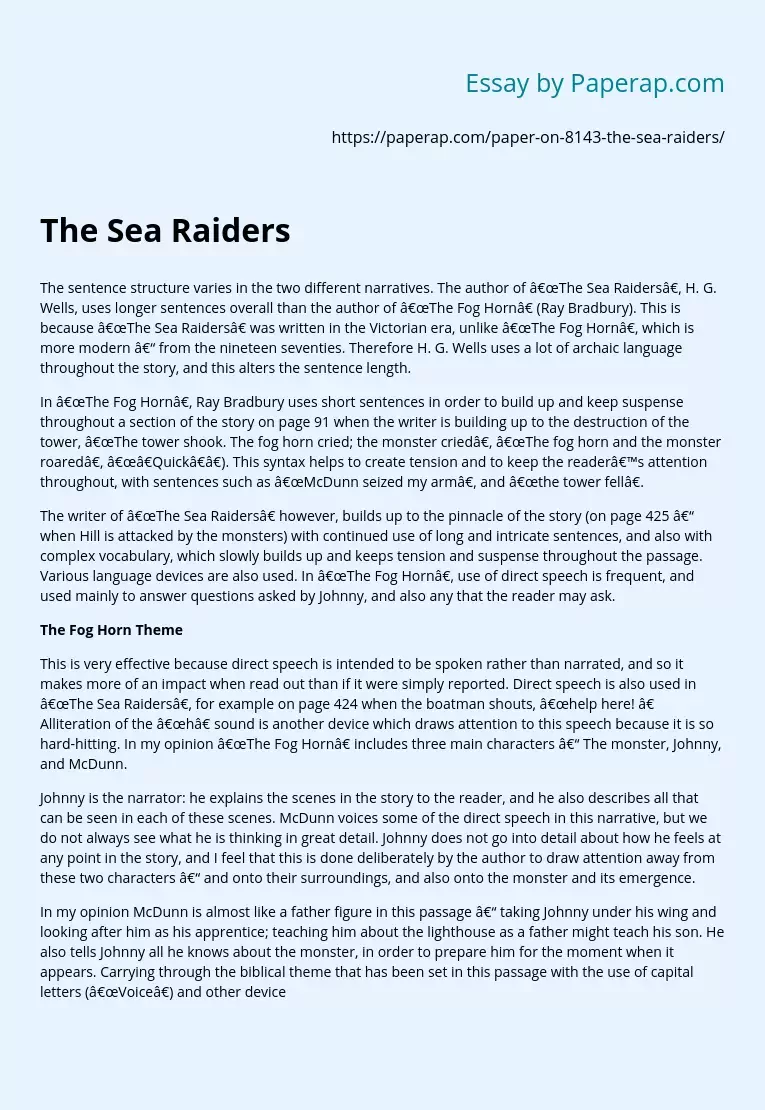The Sea Raiders
The sentence structure varies in the two different narratives. The author of “The Sea Raiders”, H. G. Wells, uses longer sentences overall than the author of “The Fog Horn” (Ray Bradbury). This is because “The Sea Raiders” was written in the Victorian era, unlike “The Fog Horn”, which is more modern – from the nineteen seventies. Therefore H. G. Wells uses a lot of archaic language throughout the story, and this alters the sentence length.
In “The Fog Horn”, Ray Bradbury uses short sentences in order to build up and keep suspense throughout a section of the story on page 91 when the writer is building up to the destruction of the tower, “The tower shook.
The fog horn cried; the monster cried”, “The fog horn and the monster roared”, “”Quick””). This syntax helps to create tension and to keep the reader’s attention throughout, with sentences such as “McDunn seized my arm”, and “the tower fell”.
The writer of “The Sea Raiders” however, builds up to the pinnacle of the story (on page 425 – when Hill is attacked by the monsters) with continued use of long and intricate sentences, and also with complex vocabulary, which slowly builds up and keeps tension and suspense throughout the passage.
Various language devices are also used. In “The Fog Horn”, use of direct speech is frequent, and used mainly to answer questions asked by Johnny, and also any that the reader may ask.
The Fog Horn Theme
This is very effective because direct speech is intended to be spoken rather than narrated, and so it makes more of an impact when read out than if it were simply reported.
Direct speech is also used in “The Sea Raiders”, for example on page 424 when the boatman shouts, “help here! ” Alliteration of the “h” sound is another device which draws attention to this speech because it is so hard-hitting. In my opinion “The Fog Horn” includes three main characters – The monster, Johnny, and McDunn.
Johnny is the narrator: he explains the scenes in the story to the reader, and he also describes all that can be seen in each of these scenes. McDunn voices some of the direct speech in this narrative, but we do not always see what he is thinking in great detail. Johnny does not go into detail about how he feels at any point in the story, and I feel that this is done deliberately by the author to draw attention away from these two characters – and onto their surroundings, and also onto the monster and its emergence.
In my opinion McDunn is almost like a father figure in this passage – taking Johnny under his wing and looking after him as his apprentice; teaching him about the lighthouse as a father might teach his son. He also tells Johnny all he knows about the monster, in order to prepare him for the moment when it appears. Carrying through the biblical theme that has been set in this passage with the use of capital letters (“Voice”) and other devices, McDunn comes across as almost god-like.
He is seemingly omniscient, and appears to know everything that is going on. He also knows everything about the monster. McDunn understands the monster’s emotions because he empathises with it, as he remains out at sea in his lighthouse, totally isolated and alone – just like the monster. We know that McDunn is often cut off from humanity because he becomes so lonely that he even fabricates stories to pass the time, for instance his story on page 87 (“I made up that story”).
As McDunn does not freely express his feelings and opinions frequently in the narrative, the only way that we can understand what he feels and thinks is through Johnny’s character, and we get an insight into the philosophical nature of McDunn. As the story progresses we start to become somewhat closely associated with Johnny, as we relate to him – because the lighthouse, the monster and McDunn are all connected and are all seemingly together as one in the story. Johnny is the outsider to the situation, and can be likened to the reader whilst they read the passage.
The story is written in the first person narrative, and we figuratively become Johnny throughout the story because we are an outsider to all that is happening. This makes the story more personal because we can relate Johnny’s point of view. In “The Sea Raiders”, we have a bird’s eye view of the story, and are not as involved, as H. G. Wells has written the narrative in the first person. “The Sea Raiders” was written in the Victorian era, and at this time many things were unknown to science – a common preoccupation of the Victorians was discovery, and it was a time of great exploration.
The society and history in which the story was written is reflected in the narrative – Mr Fison and the other men went out into the sea in their boat to try and discover more about the monsters, just as many Victorians were travelling the world to discover new things at the time that this story was written. Mr Fison and his team are keen to find out more about these monsters because they are unknown to science and society. In this way the men in the story are symbolic of the male status in society at the time that H. G. Wells wrote “The Sea-Raiders”.
The Sea Raiders. (2019, Dec 05). Retrieved from https://paperap.com/paper-on-8143-the-sea-raiders/

